
Stamps and Security features

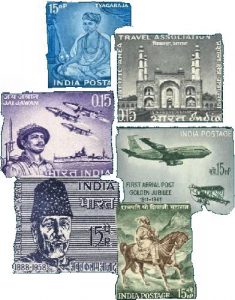
The evolution and systemic growth of Postal communication led to the introduction of stamps. The postal system can be traced over a span of centuries when a different kind of communication albeit ghost Postal system in the form of messengers carrying the messages or the birds or animal backs tied with messages existed. But they were not organised from a central point. Till 1200 to 1500 the human messengers regularly carried the messages. During Qutb-ud-din Aybak regime, a messenger cum animal Post system was established in India which was the combination of a horse and foot runner for the Postal service. While up to 15th or 16th centuries during Mogul and Persian rule in Asia, the nomenclature of Post or Postal Service did not exist, in Europe the Postal system came up somewhere in Denmark in the year 1624 though it released the first set of printed Postal stamps only in the year 1850 or so. In the year 1660 an office was created in England for receiving the written messages meant to be delivered elsewhere. But then there were no paper entries (which subsequently took the form of Postal stamps and stationery later) to affix or authenticate the dispatched messages till 18th century. Thus the meaning of stamping remained unknown till then and therefore the concept of Stamp did not exist.
Against this background emerged the concept of paper Stamps and thus the origin of Postal stamps goes back to 1840 when United Kingdom invented stamps to streamline the postal system. A schoolmaster from England, Sir Rowland Hill reportedly invented the adhesive postage stamp in the year 1837 and the official postal stamp was released by the Govt in UK in the year 1840. While inventing the stamps Sir Rowland Hill also suggested uniform rates to be adapted for the postal services and that should be based on weight rather than size of the envelope inside which the written message papers were sealed and sent. Thus Sir Rowland Hill’s invention introduced the prepayment for the mail services which not only gave regular revenue to the Govt, but also assured the delivery of messages from a single point window possible and practical. Collection of revenue by way of pre paid charges for the postal services through affixing of stamps based upon weight began to be adopted in many countries around the world as the concept was practical and would not cause loss to the agencies involved. Sir Rowland Hill’s invention of stamping became necessary as the cost for delivering mails were not recoverable from the receiver as many were not willing to pay the service charges to be collected for the letters delivered by the delivery personal.
Though the Postal stamps and postal stationery were originally introduced for only authenticating and regulating the process of messaging from one part to the other, the purpose was also to generate some kind of revenue albeit fee to the carrier agency (Govt) for services rendered to the public i.e. carrying the messages from one part to the other sent by them.
The first Postal stamp was called Penny Black the name attributed to the inventor of affixing the printed stamps on to the envelopes carrying the messages. Prior to the introduction of Penny Black stamps, certain standard size paper was printed and based on the weight of the envelope the value was indicated on them as fee for the service and tagged with each and every envelope individually and separately. Thus the stamping concept began with official sealed paper (like rubber stamping) showing certain value tagged to the envelope. Unfortunately though a step towards introduction of stamp printing, it was also not foolproof arrangement as the tagged stamped paper sometimes tore off from the tagged envelope and fell while on transit. Noticing the success of the use of stamps to be affixed on the envelope directly, many other countries followed United Kingdom in bringing out their own stamps with adhesives on their back. Initially the stamps were of square type and design. As the stamping system spread the stamps with various shapes and sizes were released by many countries in varying values.
The United States of America issued their first series of printed Stamps in the year 1847 even though much before this independent Postal service from Boston to New York existed from the year 1639 when the country was under British rule. No system or practice of affixing printed stamps were heard till 1840. Prior to unification of Germany, the then individual German states totaling to sixteen released their own stamps beginning from 1849 till 1867. The Deutsche Reichspost (name of German postal service) started Postal service officially on May 4, 1871 using North German Confederation Stamps until it issued its own stamps in the year 1872. In India the first set of stamps began to be printed in the Govt security press in Nasik from the year 1925 even though the stamps were in use during the British rule in 18th century which were got printed elsewhere.
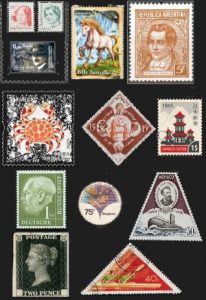
The initially introduced Postal stamps or seal as they were called did not contain any security feature, and instead they were only printed on special paper which was not available to others. Not only that, they were also counter stamped with the rubber seal of the Govt administrator to ensure that there was no misuse. In one sense the Postage stamps were akin to the labels attached with the goods when such a system was introduced and therefore it became imperative to be collected in advance by paying fixed fee and to be tagged with the letter sent from the point of letter collecting centre. This later transformed into the act of production of stamps with adhesive on their back side for pasting on to the surface of the envelopes directly instead of tagging with thread or thin wire.
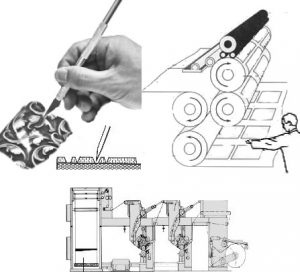
Today the Stamp printing process utilizes the finest technology available in the print world. Since the stamps have monetary value and generate revenue to the authorities, the printing of Postal Stamps and Stationery were also treated as Security printing and only governmental organizations were permitted to print them in most of the countries in which the Postal system is held by the Govt agencies or authorities.
In the initial stages when the stamps were printed, engraving process was deployed for the printing as anti counterfeit measure since everyone cannot cost effectively engrave the intricate designs required. Though the engraving process of printing was deployed for printing stamps, slowly the gravure process of printing was also introduced for printing multi coloured stamps. For a very long period Gravure process of printing remained the most sought after print process for printing the Stamps and Postal Stationery. With several technological developments, the Postage stamps were also began to be printed by Intaglio process by some of the countries. A few countries, including Sweden, Denmark, Slovakia and the Czech Republic, regularly produce and issue intaglio-printed stamps today while the postal authorities in other countries opt to use the much cheaper, faster and easier process of Dry offset process of printing to print the stamps.
No international standard or norms exist for the reproduction of stamps in specific size or the shapes and therefore the countries release stamps to suit their norms. Some of the stamps are seen printed on Water marked paper, Azure laid paper or on Rib lined paper. Each country maintain their own standards for reproduction of the Stamps.
The Stamps were printed on paper specially manufactured for them, and were printed either in sheet or rolls form. But in order to separate individual stamps from the multi up printed paper/ sheets or even from the rolls formats, perforations on all sides were introduced in between each stamp. Every postal stamp with printed images has some form of adhesive coated on its back to stick on to the surface of the envelope and has half perforations over the edges around them after they are separated from the main sheet. Most of the Stamps were coated with special adhesive on their back so that they can be slightly moistened and pasted on the envelopes.
The design elements on the stamps may appear to be very simple, but the stamps have several inbuilt security elements in them like Currencies and Bank Notes to ensure that they are not easily counterfeited. The incorporation of security features, whether it is Currencies or Stamps are limited to the following basic aspects only:
- Papers inbuilt with security features like security thread, fluorescent fibbers, water mark, special coating on paper surface etc.
- Security features by way of design elements including see through (not in stamps), Intaglio, guilloche designs, micro prints, ghost images, deliberately created broken images not visible to naked eyes etc.
- Security features on the mode of reproducing the design elements.
- Security features on the inks used which are overt or covert or with both and viewable only with special gadgets and OVI. However in respect of Stamps the two important additional features incorporated is in the design elements in perforations and adhesives used.
- Holographic stamps that show tow different colour images when viewed from different angles.
Though the earlier design elements on the stamps used to be the portrait of head of Queen or Emperors of the countries which released them, but later abstract designs changed the concept which included Birds, Animals, logos and Sports element designs reflecting important events like Olympic, World Cup, National leaders etc etc.
Micro printing is one of the security features found on the Stamps issued by some countries as anti counterfeiting feature. The word or single letters printed on the stamps are so small that it will be impossible to read the text without using a magnifying glass or microscope. The authorities aver that while for counterfeiting purpose if someone attempt to reproduce them by photocopying techniques, the micro printed text will remain illegible and will not copy in true form. Similarly some hidden images called Ghost images are also printed on stamps as part of design. Such images are visible only when the printed stamps are tilted to a particular angle and viewed with special decoder lenses thereby making it difficult to copy them for reproduction.
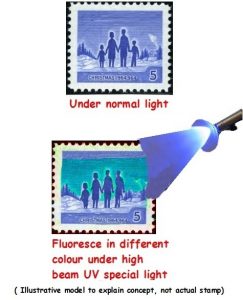
Granite paper is one of the papers used for printing of stamps as it has colored fibers or threads added to the paper pulp during the manufacturing of paper. These colored fibers or threads makes counterfeiting of stamps printed on this paper much more difficult. Besides acting as security feature the fibers also act as attractive texture and design elements to the stamp.
Most of the stamps being in lower value, low in circulation, limited quantity put to circulation, the counterfeiters generally avoid counterfeiting stamps because of the lower margin of profit. The other most important aspect that deters the counterfeiters is that the stamp designs keep on changing frequently and any huge issue for circulation will alert the investigating agencies to track the counterfeiters.
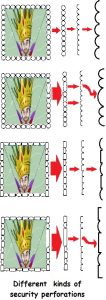
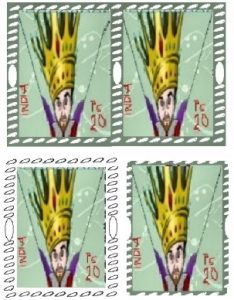
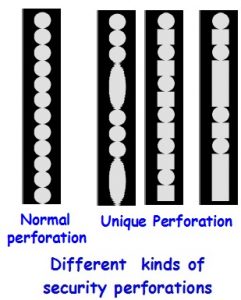
Perforation of postage stamps began in the year 1854. Standard mode of perforations leave row of half circles on all sides of the stamps once they are separated into individual stamps. Perforations are small holes made between individual postage stamps on a sheet of stamps to facilitate separation of a desired number of stamps on demand. The half circle perforations add beauty to the stamps giving frame like appearance. But in order to enhance the security feature of the stamps, the authorities have deviated from the standard round hole perforation designs into unique perforations which not only make it difficult to easily reproduce but also drastically enhanced the cost elements for the reproduction of perforation dies for the counterfeiters as the stamps are low value material and frequently changed with new designs, each having different type of perforation. The cost of reproducing such design elements in perforations is very high and not easier. A few nations, including Great Britain and the Netherlands, use syncopated or elliptical perforations that interrupt the normal pattern of perforation holes.

In an article titled ‘Stamps incorporate many security features’ written by an author called Janet Klug, in Linns.com, dated September 20, 2004, the following interesting information has been given:(http://www.linns.com/insights/stamp-collecting-basics/2004/september/stamps-incorporate-many-security-features.html#)
Quote:-
There was even an experiment to make stamps with a small amount of encapsulated gunpowder embedded in them, not unlike the roll caps or sticker caps used in the old toy guns children played with years ago. The idea was that when the stamp was struck with the cancelling device, the charge would go off and destroy the stamp, making reuse impossible.
This security measure did not last long. Production costs were high, and the noise would have jarred the nerves of postal workers who hit the stamps with the canceller.
:-Unquote













Recent Comments